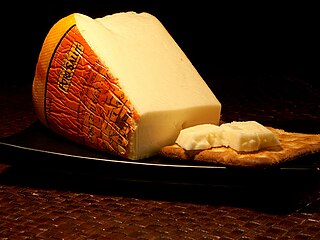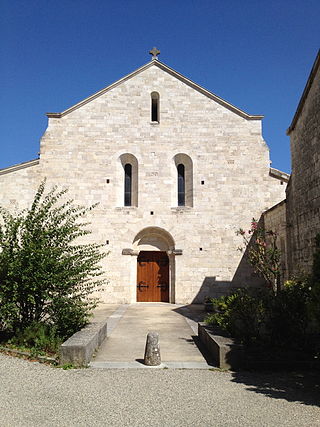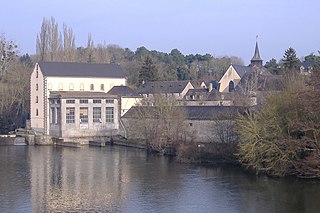
Port Salut is a semi-soft pasteurised cow's milk cheese from Pays de la Loire, France, with a distinctive orange rind and a mild flavour. The cheese is produced in wheels approximately 23 cm (9 inches) in diameter, weighing approximately 2 kg (4.4 lb).

Cîteaux Abbey is a Catholic abbey located in Saint-Nicolas-lès-Cîteaux, south of Dijon, France. It is notable for being the original house of the Order of Cistercians. Today, it belongs to the Trappists.

Trappist beer is brewed by Trappist monks. Thirteen Trappist monasteries—six in Belgium, two in the Netherlands, and one each in Austria, Italy, England, France, and Spain— produce beer, but the Authentic Trappist Product label is assigned by the International Trappist Association (ITA) to just ten breweries that meet their strict criteria. As of 2021, Achel is no longer recognized as a Trappist brewery because it does not have any monks.

Oka is a semi-soft washed rind cheese that was originally manufactured by Trappist monks located in Oka, Quebec, Canada. The cheese is named after the town. It has a distinct flavour and aroma, and is still manufactured in Oka, although now by a commercial company. The recipe was sold in 1981 by Les Pères Trappistes to the Agropur cooperative.

The Tironensian Order or the Order of Tiron was a medieval monastic order named after the location of the mother abbey in the woods of Thiron-Gardais in Perche, some 35 miles west of Chartres in France). They were popularly called "Grey Monks" because of their grey robes, which their spiritual cousins, the monks of Savigny, also wore.

Aiguebelle Abbey is a Trappist monastery situated in the communes of Montjoyer and Réauville in the département of Drôme, on the borders of the Dauphiné and of Provence, France.
The Abbey of Notre-Dame du Lac, known as the Oka Abbey, was a Trappist Cistercian monastery located in Oka, Quebec. The main monastery building is of grey stone; it has a dozen outbuildings, all of which are situated on a 270-hectare property. With a decline in the number of monks by the early 21st century, the monastery decided to end operations there and established a non-profit centre at the abbey to preserve the site's heritage.
Tamié Abbey is a Cistercian monastery, located in the Bauges mountain range in the Savoie region of France.

Godewaersvelde is a commune in the Nord department in northern France, near the Belgian border.

The Trappist Abbey of Rochefort or Abbey of Notre-Dame de Saint-Rémy, which belongs to the Cistercians of Strict Observance, is located in Rochefort in the province of Namur. The abbey is famous for its spiritual life and its brewery, which is one of few Trappist beer breweries in the world. Life in the abbey is characterised by prayer, reading and manual work, the three basic elements of Trappist life. The motto of the abbey is Curvata Resurgo.

Scourmont Abbey is a Trappist monastery on the Scourmont plateau, in the village of Forges which is part of Chimay in the province of Hainaut, Belgium. The abbey is famous for its spiritual life and for running the Chimay Brewery, one of the few producers of Trappist beer.

Trappist monks started producing Mont des Cats cheeses in 1890. The cheese is produced using cows milk from local sources and has a fat content of 50%. While maturing for at least two months the cheese is washed with salted water containing a dye made from annatto seeds which gives the rind its characteristic orange color.

Igny Abbey or Val d'Igny Abbey is a Cistercian abbey located in Arcis-le-Ponsart, Marne, France. It was founded in 1128 for Cistercian monks, dissolved in 1791 during the French Revolution, re-established in 1876 for Trappist monks, destroyed in 1918, reopened in 1929 for Trappist nuns and modernised in 2008–12 to accommodate three or four pre-existing communities.

Port-du-Salut Abbey, also the Abbey of Notre-Dame du Port du Salut is a Trappist monastery located in Entrammes, Mayenne, France. The main monastery building dates from around the 13th century.

Koningshoeven Abbey is a monastery of the Trappists founded in 1881 in Berkel-Enschot in North Brabant, the Netherlands.
Nicolas Joseph Ruyssen was a French painter and the master draughtsman of the royal princesses of England under the reign of King George III.















